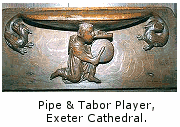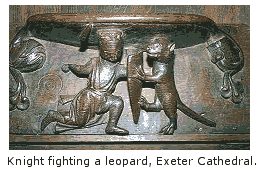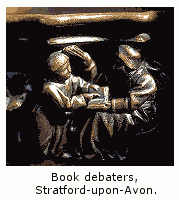|
Misericords for Heaven's Sake
by Chris Pye
About
the author: Chris Pye has been woodcarving since 1975, originally
studying under master woodcarver Gino Masero. His commissioned work
ranges from architectural to figure carving; including furniture,
lettering, bedheads, fireplaces, mythical and abstract sculpture.
Below, an excerpt from Chris Pye's online newsletter, Slipstones,
in which he answers questions and gives advice to visitors about
his craft...
What's a misericord?
Misericords are found in larger churches but not just minsters and
cathedrals, small rural churches too - basically wherever there
was an association with, or communities of, monks.
Monk's prayed and chanted a lot - an awful lot - gathering in their
stalls in the choir of the church to pray and chant many times throughout
the day and night. Tiring work, but they did each have a seat in
their stalls to sit on some of the time.
 This
seat could be flipped up out of the way when they stood to chant.
But standing to chant for hours on end was also very tiring. This
seat could be flipped up out of the way when they stood to chant.
But standing to chant for hours on end was also very tiring.
At some point, monks seats were designed with a small ledge, a bracket
or corbel, on the underside so that the poor monk could perch and
rest while standing.
The monk looked as if he was standing while actually sitting - a
bit of a cheat really!
It is this little, extra ledge or seat that is really the 'misericord';
the name comes from the Latin 'to have pity on'.
The Gothic, Medieval, period in Britain was a rich one for artistic
invention and this inventiveness was quickly applied to misericords.
The whole seat was carved from as solid block of oak and carvers
soon used the spare material for their imaginations.
When you see a picture of a misericord, as below, the seat itself
has been lifted and rests vertically against the back of the stall.
You are looking under the seat at the carving. The flat top above
the carving is the second 'ledge' for the monk to rest on when he
stood.
 Since
the carving was hidden most of the time - always when the seat was
down, and mostly when a monk stood in front of it - subject matter
was broad. Since
the carving was hidden most of the time - always when the seat was
down, and mostly when a monk stood in front of it - subject matter
was broad.
Subjects ranged from the educational (bible stories) to scatological
humour (remember the monk was sitting just on it!); fabulous beasts
such as dragons and mermaids to proverbs, stories, political satire
and the hurly-burly of everyday life.
Many misericords have meanings that can only be guessed at now.
Misericords show an extraordinary diversity and were a unique opportunity
for self-expression and individuality.
Humour
is a strong thread in misericord carving - I've been amazed by what
carvers could get away with, but this applies to other carving (such
as Green Men) that you find in churches in this period. 
One
also finds extensions of this carving style in wooden panels, arm
and hand rests, and the ends of pews for example.
Bear in mind that we are talking substantial sculpture here: a starting
block in hard English Oak might be 12" x 12" in section
and 18" long.
Not bad without power tools!
Carving
quality ranges from the crude and poorly executed to some of the
most sophisticated that we have from this period. Always, though,
you can see the hands of the makers: the tool cuts and marks; and
the patina of wear over hundreds of years.
I'll put up a category of links and books on misericords on the
website when I can. There is plenty of material 'out there'
to look at.
More
resources about woodcarving on the Web:
Chris
Pye Woodcarving
More
resources about misericords on the Web:
The
Exeter Misericords
The
Misericords Lecture
|

 This
seat could be flipped up out of the way when they stood to chant.
But standing to chant for hours on end was also very tiring.
This
seat could be flipped up out of the way when they stood to chant.
But standing to chant for hours on end was also very tiring.  Since
the carving was hidden most of the time - always when the seat was
down, and mostly when a monk stood in front of it - subject matter
was broad.
Since
the carving was hidden most of the time - always when the seat was
down, and mostly when a monk stood in front of it - subject matter
was broad. 